
Tropaeolum, commonly known as nasturtium, is a genus of roughly 80 species of annual and perennial herbaceous flowering plants. It was named by Carl Linnaeus in his book Species Plantarum, and is the only genus in the family Tropaeolaceae. The nasturtiums received their common name because they produce an oil similar to that of watercress.

Watercress or yellowcress is a species of aquatic flowering plant in the cabbage family Brassicaceae.

Ipomoea cairica is a vining, herbaceous, perennial plant with palmate leaves and large, showy white to lavender flowers. A species of morning glory, it has many common names, including mile-a-minute vine, Messina creeper, Cairo morning glory, coast morning glory and railroad creeper. The species name cairica translates to "from Cairo", the city where this species was first collected.

Vinca major, with the common names bigleaf periwinkle, large periwinkle, greater periwinkle and blue periwinkle, is a species of flowering plant in the family Apocynaceae, native to the western Mediterranean. Growing to 25 cm (10 in) tall and spreading indefinitely, it is an evergreen perennial, frequently used in cultivation as groundcover.

Adenium obesum is a poisonous species of flowering plant belonging to the tribe Nerieae of the subfamily Apocynoideae of the dogbane family, Apocynaceae. It is native to the Sahel regions south of the Sahara, tropical and subtropical eastern and southern Africa and also the Arabian Peninsula. Common names include Sabi star, kudu, mock azalea, impala lily and desert rose. Adenium obesum is a popular houseplant and bonsai in temperate regions.

Caputia tomentosa, known as the woolly senecio and the matted caputia, is a perennial, succulent dwarf shrub of the Caputia genus that grows in the Cape Provinces of South Africa, usually between the altitudes of 900 and 1200 meters. It has been introduced to Myanmar. It has gained the Royal Horticultural Society's Award of Garden Merit as an ornamental.

Tropaeolum majus, the garden nasturtium, nasturtium, Indian cress or monks cress, is a species of flowering plant in the family Tropaeolaceae, originating in the Andes from Bolivia north to Colombia. An easily-grown annual or short-lived perennial with disc-shaped leaves and brilliant yellow, orange or red flowers, it is of cultivated, probably hybrid origin. It is not closely related to the genus Nasturtium.
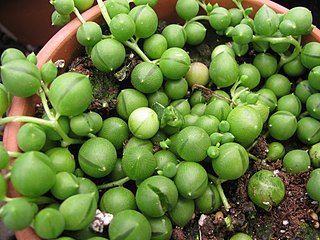
Curio rowleyanus, syn. Senecio rowleyanus, is a flowering plant in the daisy family Asteraceae. It is a creeping, perennial, succulent vine native to the drier parts of southwest Africa. In its natural environment its stems trail on the ground, rooting where they touch and form dense mats. It often avoids direct sunlight by growing in the shade of other plants and rocks. It is commonly known as string-of-pearls or string-of-beads.

Delairea is a plant genus within the family Asteraceae that is native to South Africa. Classified within the tribe Senecioneae, it contains only one species, Delairea odorata, which was previously included in the genus Senecio as Senecio mikanioides. It is known as Cape ivy in some parts of the world (US) and German ivy in others. Other names include parlor ivy and Italian ivy.

Senecio angulatus, also known as creeping groundsel and Cape ivy, is a succulent flowering plant in the family Asteraceae that is native to South Africa. Cape ivy is a scrambling herb that can become an aggressive weed once established, making it an invasive species. It has been naturalised in the Mediterranean Basin, where it is grown as an ornamental plant for its satiny foliage and sweet-scented flowers. Other names include climbing groundsel, Algerian senecio, and scrambling groundsel.

Senecio tamoides, also known as Canary creeper, false grapevine, and parlor ivy, is a climbing member of the genus Senecio of the family Asteraceae that is native to Southern Africa. It is used as an ornamental plant for its showy yellow, daisy-like flowers in autumn through to winter.
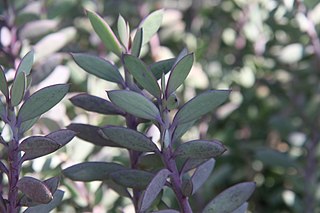
Senecio crassissimus, the propeller plant, vertical leaf or lavender steps, is a succulent species of flowering plant in the daisy family Asteraceae, and is endemic to the island of Madagascar off the east coast of Africa.

Curio archeri, syn. Senecio toxotis is a species of succulent plant in the family Asteraceaethat is indigenous to the south-western Cape, South Africa.

In botany, succulent plants, also known as succulents, are plants with parts that are thickened, fleshy, and engorged, usually to retain water in arid climates or soil conditions. The word succulent comes from the Latin word sucus, meaning "juice" or "sap".

Jatropha cathartica is a species of flowering plant in the spurge family, Euphorbiaceae, that is native to Texas in the United States and Coahuila, Nuevo León and Tamaulipas in northeastern Mexico. Common names include jicamilla (Spanish) and Berlandier's nettlespurge.
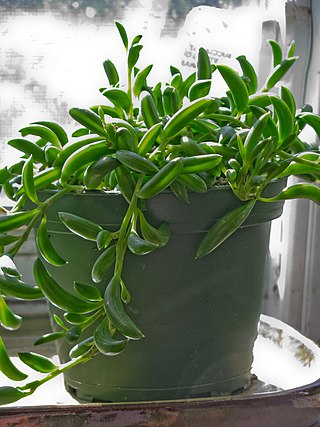
Curio radicans, syn. Senecio radicans, is a succulent houseplant that is native to South Africa. A member of the family Asteraceae, the asters, this species is closely related to the common string of pearls and Curio hallianus. It has multiple tendrils of glossy, banana-shaped foliage. It is commonly known as string of bananas or fishhook senecio.

Kalanchoe longiflora, also known as tugela cliff-kalanchoe or long-flower kalanchoe, is a species of the succulent genus Kalanchoe, in the family Crassulaceae. An obscure shrub native to South Africa, it is known for its multi-coloured foliage and yellow flowers, which bloom in autumn to winter.
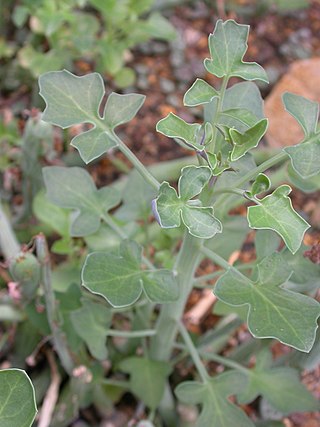
Curio articulatus, syn. Senecio articulatus, which is also known as candle plant, pickle plant and hot dog cactus, is a deciduous succulent plant that is native to South Africa.
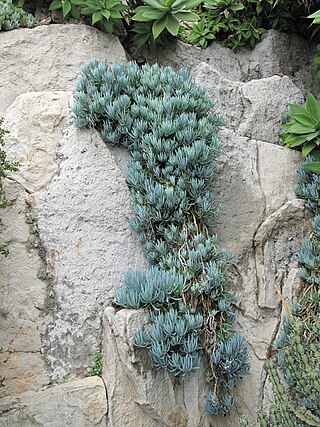
Curio talinoides, syn. Senecio mandraliscae, also known as blue straws, blue chalksticks, dassieharpuis, or narrow-leaf chalk sticks, is a succulent plant of the family Asteraceae that is native to South Africa. The origin of this plant is dubious and it may be a hybrid.
Kedrostis africana is a species of flowering plant in the family Cucurbitaceae. It is native to Namibia and South Africa. It has gained the Royal Horticultural Society's Award of Garden Merit as an ornamental.
























